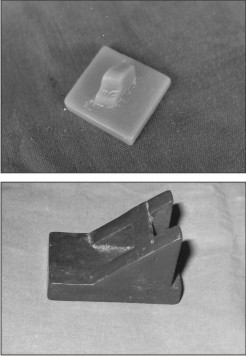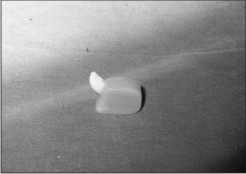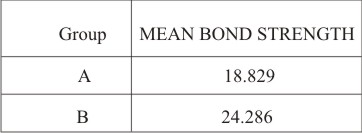|
|
|
| Effect Of Horizontal Retention Grooves On Tooth Denture Base Bond: In-vitro Study |
Luthra RP 1 , Renu Gupta 2 , Divy Vashisht 3 , Naveen Sharma 4 , Ranjan Gupta 5
1 Professor and Head H P Government - Dental College And Hospital Shimla. (H P)
2 Assistant Professor H P Government - Dental College And Hospital Shimla. (H P)
3 Senior Lecturer H P Government - Dental College And Hospital Shimla. (H P)
4 Senior Lecturer H P Government - Dental College And Hospital Shimla. (H P)
5 Senior Lecturer H P Government - Dental College And Hospital Shimla. (H P)
|
| Address For Correspondence |
Dept of Prosthodontics
H P Government Dental College and Hospital
Shimla-171001(HP)
Email:dr.rpluthra@gmail.com, dr.renugupta@gmail.com
Phone No: 09418024220,09418488807 |
| Abstract |
| The detachment of anterior acrylic resin teeth from maxillary dentures is an all too frequent occurrence. This detachment is commonly found at the tooth –denture base resin interface. The present study was conducted to compare & evaluate the effect of horizontal retention grooves placed on the ridge lap area of acrylic resin teeth on tooth –denture base bond.
80 maxillary central incisors of acrylic resin were selected for the study & divided into two groups of 40 each. Group-A served as a control group where no mechanical preparation of the tooth was done. In group B –horizontal groove was cut into the ridge lap area of the tooth. These teeth were attached to the wax mold & processed in standard denture base resin. Maximum force causing fracture at the interface was noted by using Universal Instron Machine. The result show that the horizontal grooves prepared on the ridge lap area of acrylic resin teeth provide superior bond strength than that provided by acrylic resin teeth without grooves. |
|
| Keywords |
| Detachment, Bond Strength, Ridge Lap Area, Interface, Groove |
|
| Full Text |
INTRODUCTION
Acrylic teeth are commonly used in complete or partial dentures because they chemically bond to the acrylic resin denture base material & are easier to adjust. The denture base material most commonly employed in the construction of dentures is the heat cure acrylic resin. The detachment of acrylic resin teeth from dentures is a common clinical problem1-2. This detachment is commonly found at the tooth –denture base interface. The various factors3-4 have been attributed to the bonding failures between the teeth & the denture base. These factors may be excessive stress failure, the mechanical preparation of teeth, poor lab techniques, and nature of denture base resin.
Civajan et al stressed5 in their study that adequate retention of acrylic teeth to fluid resin denture basses could be obtained by judicious grinding of the ridge laps before processing. Retentive grooves placed in the ridge laps of the denture teeth increase the area available for physical & chemical bonding & secure the teeth to the denture base more firmly6. Bond between the denture teeth & denture base is improved when teeth have large ridge laps, when vertical high impact resin is used7.The present study was conducted to determine whether horizontal retention grooves cut into the ridge lap portion of acrylic resin teeth would improve the bond strength between acrylic resin teeth and the denture base.
MATERIALS AND METHODS
The present study was conducted by preparing 80 specimens, 40 for each group i.e A & B. Maxillary central incisors of acrylic resin were selected for the study (fig 1).
 | (Fig 1)
 |
Group - A: it served as a control group where no mechanical preparations of the ridge lap area of the teeth were carried out.
Group - B: a groove 2mm.wide and 2mm.deep was cut in a mesio-distal direction with a straight fissure bur, (diameter of the bur being 2mm) bisecting ridge lap surface of tooth.
These teeth were attached to the wax molds prepared on the stone casts secured from the polyvinyl siloxane impressions obtained from the maxillary acrylic master die.
 | (Fig 2) and (Fig 3)
 |
A specially designed wooden inclined plane (fig 3)was used to obtain and ensure the position of the tooth at an angle of 130 degree to the base of the specimen to be tested (fig 4).
 | (Fig 4)
 |
Then these specimens were flasked, the wax was boiled out, mold was packed by using long curing cycle, started at room temperature and raise to 165° F. The cured specimens were de-flasked, finished & polished (fig 5).
 | (Fig 5)
 |
All specimens were prepared with this method.
The specimens were stored at room temperature in plastic bags containing distilled water for 7- days before testing. Each specimen was tested in an Instron Universal Testing Machine. A 5mm. bar was placed on the lingual surface of the teeth at 13o degree angle in relation to the long axis of the tooth. The Instron instrument was set at the cross head speed of 2mm/mt. and 5 kg. load cell. The specimens were loaded until fracture at the interface occurred. (fig 6)
 | (Fig 6)
 |
RESULTS :
TABLE –I shows the maximum force required for de-bonding acrylic resin teeth from standard heat cure acrylic resin denture base.
Bond Strength Evaluation.
 | TABLE-I : FORCE REQUIRED IN KGF TO SEPARATE ACRYLIC RESIN TEETH. FROM HEAT CURE ACRYLIC RESIN DENTURE BASE MATERIAL.
 |
TABLE II
presents mean bond strength of two groups.
 | TABLE-II: PRESENTING MEAN BOND STRENGTH
 |
The inference drawn from the present study is that the horizontal grooves made in the ridge lap area of acrylic resin teeth provide statistically superior (at 1% probability level) bond strength than that provided by acrylic resin teeth without grooves.
DISCUSSION:
In all specimens the tooth was attached to the base at an angle of 130 degree because in a class –I occlusion this angle simulates the average angle of contact found between the maxillary and mandibular anterior teeth7.
Mechanical preparation of ridge lap area of acrylic resin teeth (horizontal grooves) cut into the ridge lap area of teeth provide statistically superior (at 1% probability level) bond strength than that provided by acrylic resin teeth without grooves . These findings are in concurrence with the findings of the studies conducted by Civjan Simon et al (1972)5,Can G, kansu G (1990) 8&Vallitu P.K (1995)9Where they concluded that the use of mechanical retention is a primary means of securing the bond between acrylic resin teeth and heat cured denture base. The grooves increase the surface area of ridge lap and hence improve bond strength.
CLINICAL IMPLICATION:
The results of this in-vitro study suggests that the retentive horizontal grooves can be placed on the ridge lap area of the acrylic resin denture teeth to enhance the bond strength at the tooth denture base interface. These retentive grooves increase the area available for physical and chemical bonding between acrylic resin teeth and the denture base. These grooves are usually placed by the dental technician before the packing stage.
SUMMARY & CONCLUSION:
The conclusion drawn from the study was that the bond strength achieved at the tooth denture base interface may be increased by preparing horizontal grooves in the ridge lap area of the acrylic resin teeth.
Horizontal grooves made in the ridge lap area of acrylic resin teeth provide statistically superior (at 1%probability level) bond strength than provided by specimens without grooves.
REFERENCES:
1. Hugget R,John G.Jagger RG,Bates JF, Strength of acrylic denture base tooth bond.Br.Dent J 1982;153:187-90
2. Spartely MH. An investigation of the adhesion of acrylic resin teeth to dentures. J Prosthet Dent 1987:58:389-92.
3. Schoonover IC, Fisher TE, Serio AF, Sweeney WT, Bonding of Plastic teeth to heat cured denture base resins. J Am Dent Assoc 1952;44:285-87.
4. Morrow RM, Matvias FM,Windeler AS, Fuchs RJ,Bonding of plastic teeth to two heat curing denture resins,J Prosthet dent 1978,39:565-68.
5. Civjan Simon, Huget EF, Simon Laszlo B.de: Modifications of fluid resin technique. J.Am.Dent.Assoc., 85: 109-112,1972.
6. Brewer AA and Morrow RM:Overdentures. Second edition 1980.The C.V.Mosby Company, P.117.
7. Cardash HS, Applebaum B, Baharav H and Liberman R:Effect of retention grooves on tooth denture base bond.J.Prosthet.Dent.,64 (4):492-96,1990
8. Can G, Kansu G:An evaluation of bond strength of plastic teeth to the acrylic denture base materials. Ankara Univ. Hekim Fak Derg 1990,17 (1): 97-101
9. Vallitu PK:Bonding of resin teeth to the polymethylmeth-acrylate denture base material.Acta.Odontol.Scan.,55:99-104,1995.
|
|
|
|
|
|
|